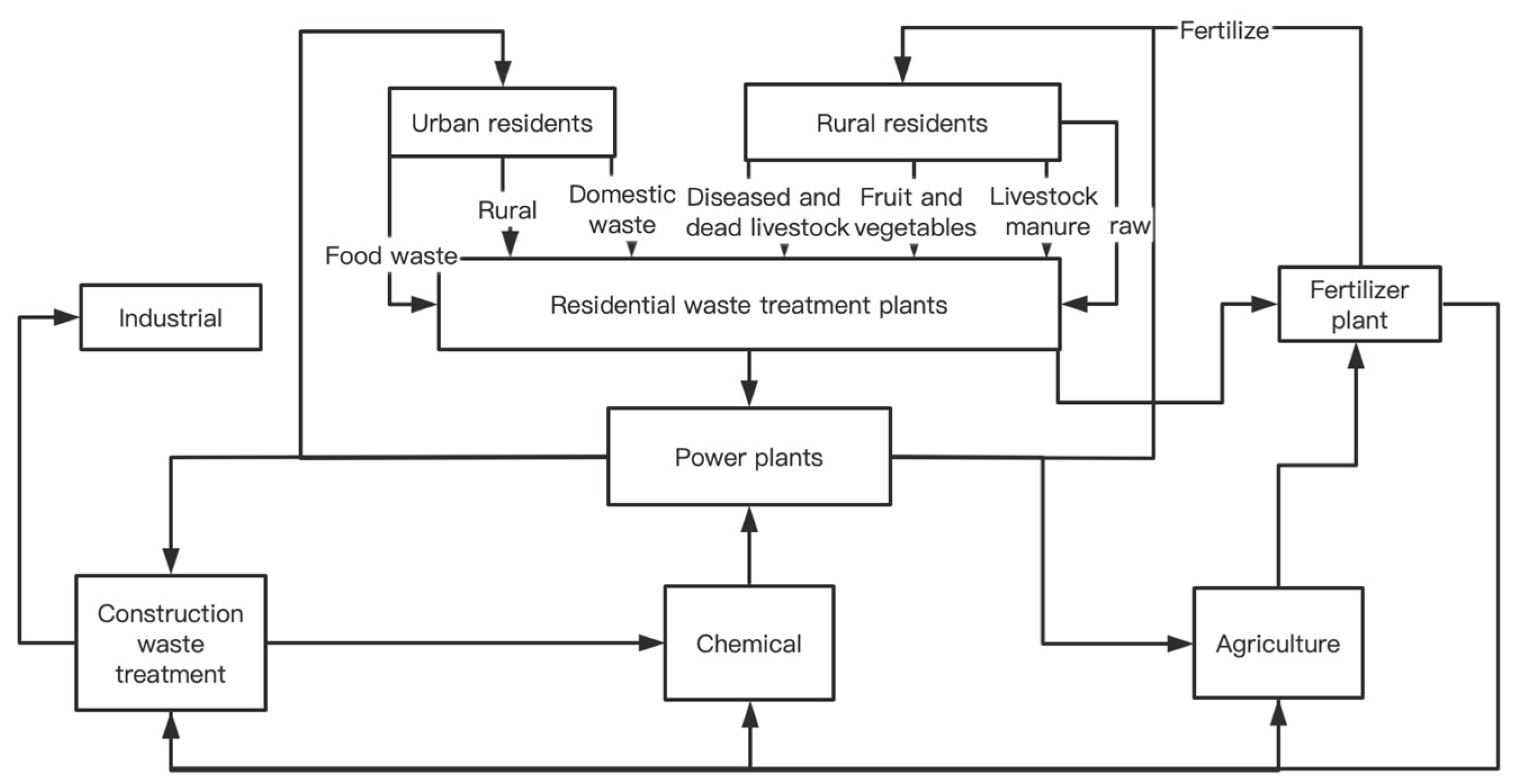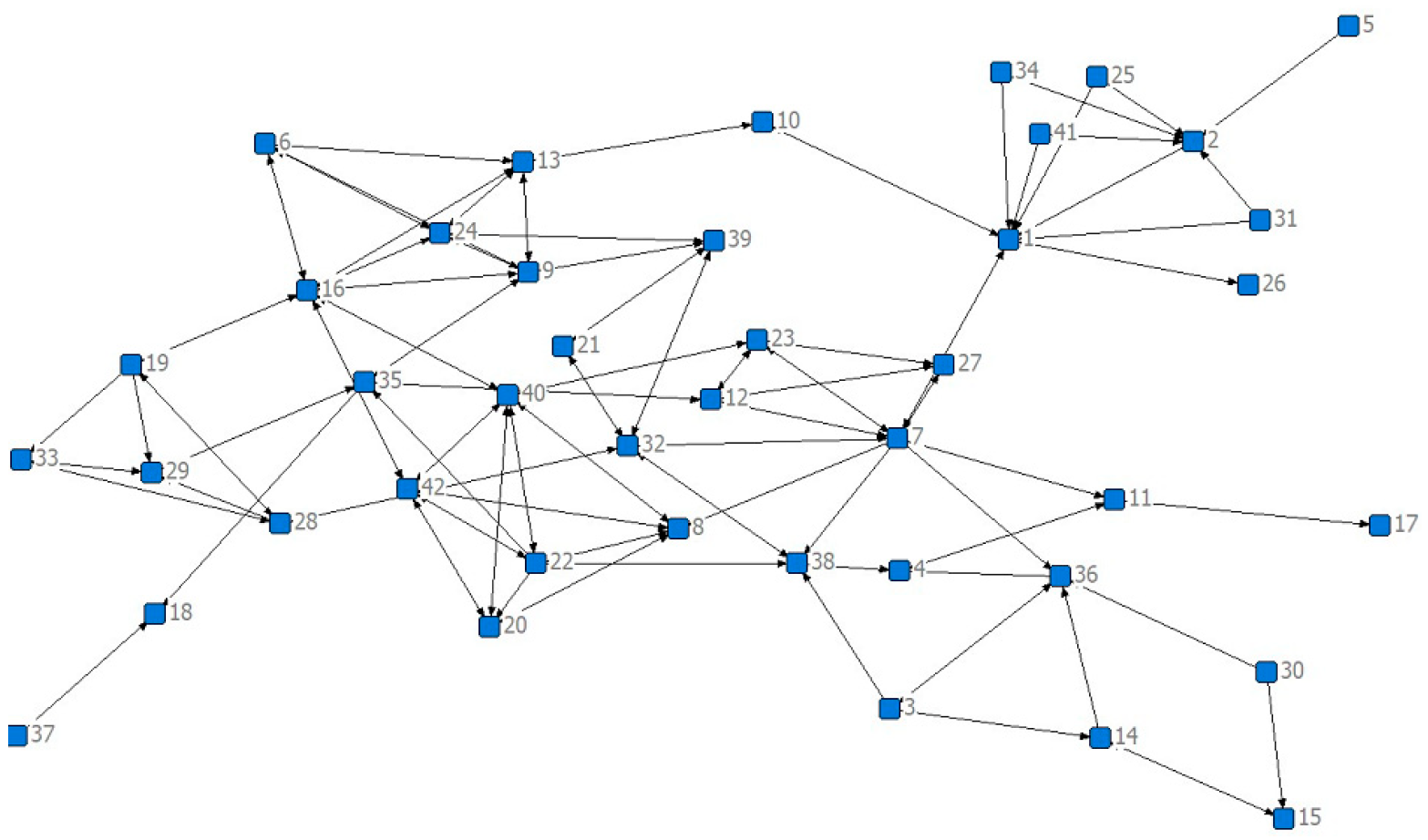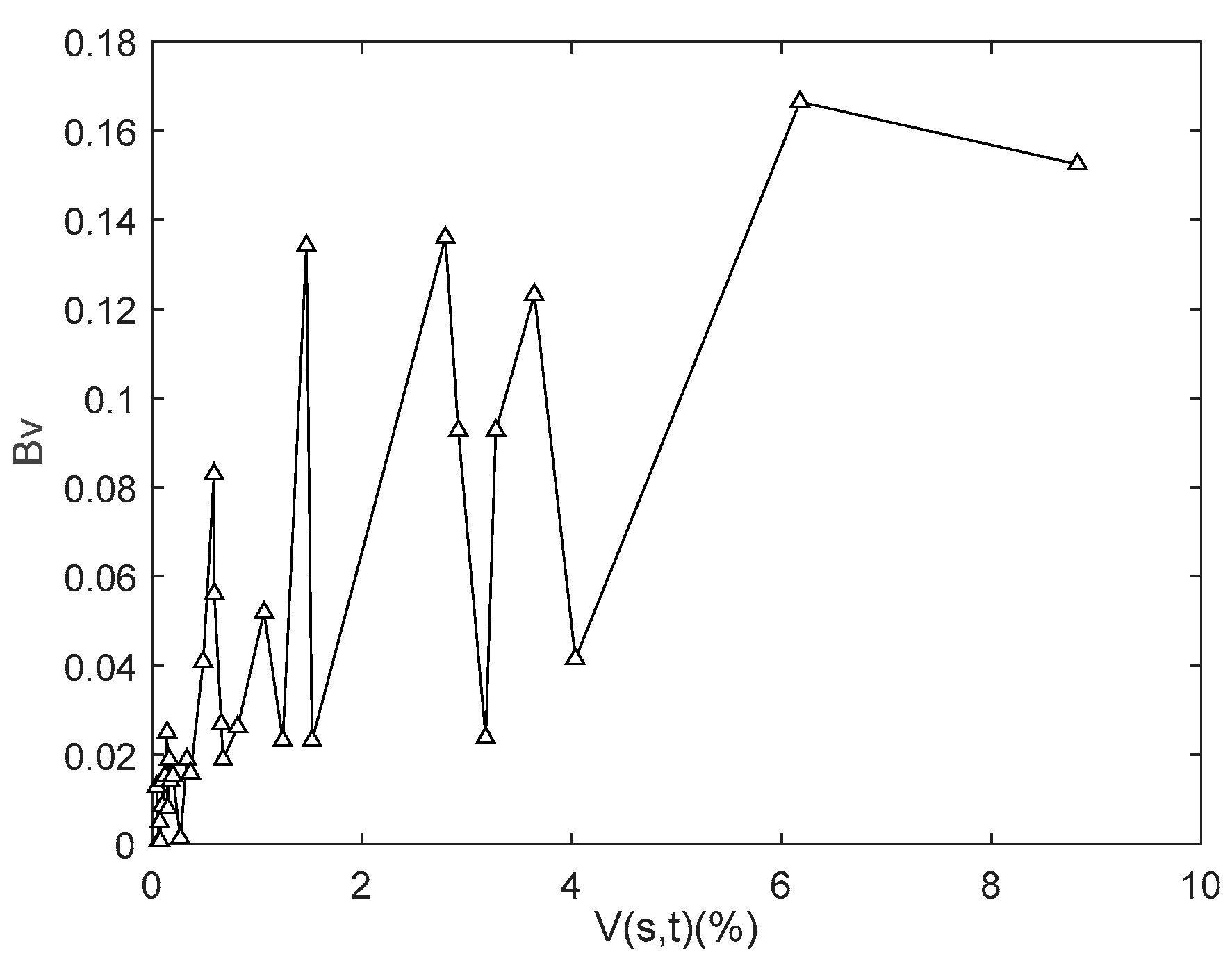Study on the Vulnerability of Municipal Solid Waste Resource Symbiosis Network—A Case Study Based on the Construction of Zero Waste City in Panjin
Abstract
:1. Introduction
2. Research Methodology
2.1. Qualitative Methods
2.2. Simulation Analysis
3. Vulnerability Analysis of MSWRSN
3.1. Topology Diagram of MSWRSN
3.2. Vulnerability Assessment of MSWRSN
4. Simulation
4.1. A Brief Introduction to Panjin
4.2. Construction of the Topology for MSWRSN
4.3. Simulation Experiment and Data Analysis
4.3.1. Single Node Failure Mode
4.3.2. Edge Failure Mode
5. Discussion and Recommendations
5.1. The City Should Promote the Construction of Solid Waste Information Technology
5.2. The Government Should Pay Attention to the Operation of the Core Business, Identify Abnormalities and Make Adjustments in a Timely Manner
5.3. Relevant Departments Carry out Technology Innovation Demonstrations and Build Technology Innovation Networks
6. Conclusions
Author Contributions
Funding
Data Availability Statement
Conflicts of Interest
References
- Mahdavi, M.; Vera, D. Importance of renewable energy sources and agricultural biomass in providing primary energy demand for Morocco. Int. J. Hydrogen Energy 2023, in press. [Google Scholar] [CrossRef]
- Ying, C.; Jing, T.; Na, Z. The meaning, objectives and construction of the “zero waste city” pilot project Pathways. Environ. Prot. 2019, 47, 21–25. [Google Scholar] [CrossRef]
- General Office of the State Council of the People’s Republic of China. The Pilot Work Plan for the Construction of ‘Zero-Waste Cities’ (In Chinese). 2018. Available online: https://www.gov.cn/zhengce/con-tent/2019-01/21/content_5359620.htm (accessed on 21 February 2020).
- Awasthi, A.K.; Cheela, V.S.; D’adamo, I.; Iacovidou, E.; Islam, M.R.; Johnson, M.; Miller, T.R.; Parajuly, K.; Parchomenko, A.; Radhakrishan, L.; et al. Zero waste approach towards a sustainable waste management. Resour. Environ. Sustain. 2021, 3, 100014. [Google Scholar] [CrossRef]
- Lee, R.P.; Meyer, B.; Huang, Q.; Voss, R. Sustainable waste management for zero waste cities in China: Potential, challenges and opportunities. Clean Energy 2020, 4, 169–201. [Google Scholar] [CrossRef]
- Chen, X.; Dong, M.; Zhang, L.; Luan, X.; Cui, X.; Cui, Z. Comprehensive evaluation of environmental and economic benefits of industrial symbiosis in industrial parks. J. Clean Prod. 2022, 354, 131635. [Google Scholar] [CrossRef]
- Wadström, C.; Johansson, M.; Wallén, M. A framework for studying outcomes in industrial symbiosis. Renew. Sustain. Energy Rev. 2021, 151, 111526. [Google Scholar] [CrossRef]
- Chopra, S.S.; Khanna, V. Understanding resilience in industrial symbiosis networks: Insights from network analysis. Environ. Manag. 2014, 141, 86–94. [Google Scholar] [CrossRef]
- Allenby, B.; Fink, J. Toward inherently secure and resilient societies. Science 2005, 309, 1034–1036. [Google Scholar] [CrossRef] [Green Version]
- Behera, S.K.; Kim, J.H.; Lee, S.Y.; Suh, S.; Park, H.S. Evolution of ‘designed’ industrial symbiosis networks in the Ulsan Eco-industrial Park: ‘research and development into business’ as the enabling framework. J. Clean. Prod. 2012, 29, 103–112. [Google Scholar] [CrossRef]
- Khan, Z.A.; Chowdhury, S.R.; Mitra, B.; Mozumder, M.S.; Elhaj, A.I.; Salami, B.A.; Rahman, M.M.; Rahman, S.M. Analysis of industrial symbiosis case studies and its potential in Saudi Arabia. J. Clean. Prod. 2022, 385, 414. [Google Scholar] [CrossRef]
- Maqbool, A.S.; Alva, F.M.; Van Eetvelde, G. An assessment of European information technology tools to support industrial symbiosis. Sustainability 2019, 11, 131. [Google Scholar] [CrossRef] [Green Version]
- Lyons, D. Integrating waste, manufacturing and industrial symbiosis: An analysisof recycling, remanufacturing and waste treatment firms in Texas. Local Environ. 2005, 10, 71–86. [Google Scholar] [CrossRef]
- Blasi, A.; Verardi, A.; Sangiorgio, P. The zero-waste economy: From food waste to industry. Membr. Eng. Circ. Econ. 2022, 3, 63–100. [Google Scholar] [CrossRef]
- Patricio, J.; Axelsson, L.; Blomé, S.; Rosado, L. Enabling industrial symbiosiscollaborations between SMEs from a regional perspective. J. Clean Prod. 2018, 202, 1120–1130. [Google Scholar] [CrossRef]
- Taddeo, R.; Simboli, A.; Morgante, A.; Erkman, S. The development of industrialsymbiosis in existing contexts. Experiences from three Italian clusters. Ecol. Econ. 2017, 139, 55–67. [Google Scholar] [CrossRef]
- Lybaek, R.; Christensen, T.B.; Thomsen, T.P. Enhancing policies for deployment of Industrial symbiosis—What are the obstacles, drivers and future way forward? J. Clean. Prod. 2021, 280, 124351. [Google Scholar] [CrossRef]
- Fric, U. Socio-cultural aspects and barriers of industrial symbiosis—The good, the bad and the ugly: Which ones matter and why. In Proceedings of the 4th International Conference on Economics, Political and Law Science, Rome, Italy, 7–9 November 2015; pp. 125–131. [Google Scholar]
- Herczeg, G.; Akkerman, R.; Hauschild, M.Z. Supply chain collaboration in industrial symbiosis networks. J. Clean. Prod. 2018, 171, 1058–1067. [Google Scholar] [CrossRef] [Green Version]
- Södergren, K.; Palm, J. The role of local governments in overcoming barriers to industrial symbiosis. Clean. Environ. Syst. 2021, 2, 100014. [Google Scholar] [CrossRef]
- Tao, Y.; Evans, S.; Wen, Z.; Ma, M. The influence of policy on industrial symbiosis from the Firm’s perspective: A framework. J. Clean. Prod. 2019, 213, 1172–1187. [Google Scholar] [CrossRef]
- Bain, A.; Shenoy, M.; Ashton, W.; Chertow, M. Industrial symbiosis and wasterecovery in an Indian industrial area. Resour. Conserv. Recycl. 2010, 54, 1278–1287. [Google Scholar] [CrossRef]
- Li, Y.; Shi, L. The Resilience of interdependent industrial symbiosis networks:a case of Yixing economic and technological development zone. Ind. Ecol. 2015, 19, 264–273. [Google Scholar] [CrossRef]
- Singhal, S.; Kapurb, A. Industrial estate planning and management in India—An integrated approach towards industrial ecology. Environ. Manag. 2002, 66, 9–29. [Google Scholar] [CrossRef] [PubMed]
- Sokka, L.; Lehtoranta, S.; Nissinen, A.; Melanen, M. Analyzing the environmental benefits of industrial symbiosis: Life cycle assessment applied to a Finnish forest industry complex. Ind. Ecol. 2011, 15, 137–155. [Google Scholar] [CrossRef]
- Sokka, L.; Pakarinen, S.; Melanen, M. Industrial symbiosis contributing to more sustainable energy use e an example from the forest industry in Kymenlaakso. Finl. Clean. Prod. 2011, 19, 285–293. [Google Scholar] [CrossRef]
- Geng, Y.; Fu, J.; Sarkis, J.; Xue, B. Towards a national circular economy indicator system in China: An evaluation and critical analysis. Clean. Prod. 2012, 23, 216–224. [Google Scholar] [CrossRef]
- Sendra, C.; Gabarrell, X.; Vicent, T. Material flow analysis adapted to an industrial area. J. Clean. Prod. 2007, 15, 1706–1715. [Google Scholar] [CrossRef]
- Kurup, B.; Stehlik, D. Towards a model to assess the sustainability implica-tions of industrial symbiosis in eco-industrial parks. Prog. Ind. Ecol. 2009, 6, 103–119. [Google Scholar] [CrossRef]
- Pakarinen, S.; Mattila, T.; Melanen, M.; Nissinen, A.; Sokka, L. Sustainability and industrial symbiosisdthe evolution of a Finnish forest industry complex. Resour. Conserv. Recycl. 2010, 54, 1393–1404. [Google Scholar] [CrossRef]
- Nair, A.; Vidal, J.M. Supply network topology and robustness against disruptions e an investigation using multi-agent model. Int. Prod. Res. 2011, 49, 1391–1404. [Google Scholar] [CrossRef]
- Xiao, Z.; Cao, B.; Sun, J.; Zhou, G. Culture of the stability in an eco-industrial system centered on complex network theory. J. Clean. Prod. 2016, 113, 730–742. [Google Scholar] [CrossRef]
- Wang, G.; Feng, X.; Chu, K.H. A novel approach for stability analysis of in-dustrial symbiosis systems. J. Clean. Prod. 2013, 39, 9–16. [Google Scholar] [CrossRef]
- Zeng, Y.; Xiao, R.; Li, X. Vulnerability Analysis of Symbiosis Networks of Industrial Ecology Parks. Procedia Comput. Sci. 2013, 17, 965–972. [Google Scholar] [CrossRef] [Green Version]
- Zeng, Y. Evaluation of node importance and invulnerability simulation analysis in complex load- network. Neurocomputing 2020, 416, 158–164. [Google Scholar] [CrossRef]
- Erdos, P.; Renyi, A. Academy of Sciences; Publications of the Mathematical Institute of the Hungarian; Academy of Sciences: Budapest, Hungary, 1956. [Google Scholar]
- Recycling Technologies. Technology. Available online: https://recyclingtechnologies.co.uk/technology/ (accessed on 30 April 2020).
- Cottrill, K. Speedier supply chains. Traffic World 2000, 261, 16–17. [Google Scholar]
- Henriques, J.; Ferrão, P.; Castro, R.; Azevedo, J. Industrial symbiosis: A sectoralanalysis on enablers and barriers. Sustainability 2021, 13, 1723. [Google Scholar] [CrossRef]
- Cárcamo, E.A.B.; Peñabaena-Niebles, R. Opportunities and challenges for the waste management in emerging and frontier countries through industrial symbiosis. J. Clean. Prod. 2022, 363, 132607. [Google Scholar] [CrossRef]
- Ma, W.; de Jong, M.; Zisopoulos, F.; Hoppe, T. Introducing a classification framework to urban waste policy: Analysis of sixteen zero-waste cities in China. Waste Manag. 2023, 165, 94–107. [Google Scholar] [CrossRef]
- Bui, T.-D.; Tseng, J.-W.; Tseng, M.-L.; Wu, K.-J.; Lim, M.K. Municipal solid waste management technological barriers: A hierarchical structure approach in Taiwan. Resour. Conserv. Recycl. 2022, 190, 2023. [Google Scholar] [CrossRef]
- Folke, C. Resilience: The emergence of a perspective for social–ecological systems analyses. Glob. Environ. Change 2006, 16, 253–267. [Google Scholar] [CrossRef]
- Pheng, L.S.; Ying, L.J.; Kumaraswamy, M. Resilience and vulnera-bility: Complementary or conflicting concepts? Ecol. Soc. 2010, 15, 11. [Google Scholar] [CrossRef]




| Methods | Characteristics | Literature |
|---|---|---|
| life cycle assessment | This method considers the energy and material supply chain. It is used to evaluate the environmental impacts arising from resource utilization and services. The approach avoids the transformation of environmental impact issues in different life cycle stages, in different regions, and in different environmental standards contexts. | Sokka et al., 2011a [25] 2011b [26] |
| material flow analysis | This method starts with the quality of the physical object. It is divided into three parts: input, storage, and output. The flow characteristics and transformation efficiency in a specific region are revealed. | Geng et al., 2012 [27] Sendra et al., 2007; [28] |
| environmental indicator | This method is based on the development of an evaluation model to conduct environmental governance evaluation. | Kurup and Stehlik, 2009; [29] Pakarinen et al., 2010; [30] |
| network theory | This approach studies the impact of network structure and unit relationships on the organization. | Nair and Vidal, 2011 [31] Chopra and Khanna, 2014 [8] |
| Time | Number of Participants | Accessing Data | |
|---|---|---|---|
| Participant observation | from 2020-10-08 to 2021-10-12 | 15 | Government Documents |
| Waste Recycling Management Process | |||
| In-person and telephone interviews | from 2021-04-15 to 2022-05-12 | 20 | Input of waste resources from selected companies |
| Output data | |||
| List of participants in the questionnaire | |||
| Questionnaire survey | from 2021-06-15 to 2021-08-12 | 93 | Inputs of waste resources from selected companies |
| Output data | |||
| Risk management situation |
| Symbiosis Unit Category | Major Projects | Major Companies |
|---|---|---|
| Residents | Domestic waste landfills Medical waste incineration Sludge drying Domestic waste incineration for power generation | Panjin Jinghuan Environmental Protection Technology Co. Panjin Xinlitong Recycling Resources Co. |
| Industrial | Oil sludge resource utilization and harmless disposal Comprehensive utilization of construction waste to produce aggregates and masonry bricks Waste tire resource recycling Chemical catalytic recycling and reuse comprehensive project | Panjin Liaohe Oilfield Yuanda Oil Sludge Treatment Treatment and Utilization Co. Shenghong Group Panjin Yuwang Waterproof Building Material Group Panjin Xinyanyuan Chemical Industry Co. |
| Mines | Drilling process of “no mud on the ground” Reduction of landed mud at source Disposal of waste mud and paving of well sites, roads, and other construction materials, etc. Resourceful use and harmless disposal of oil sludge | CNOOC Liaoning River Oilfield Branch Changcheng Drilling Company of CNOOC Liaoninghe Oilfield Branch Sinopec Liaohe Oilfield Xinglongtai Oil Production Plant Panjin Liaohe Oilfield Liaohe Industrial Group Co. Panjin Liaohe Oilfield Yuanda Oil Sludge Treatment and Utilization Co. Panjin Liaohe Oilfield Yuanda Oil Sludge Treatment and Utilization Co. |
| Agriculture | Comprehensive utilization of vegetable oil by-products Centralized heating and power supply of rice husk fuel Comprehensive utilization of crop straw Comprehensive utilization of livestock and poultry manure | Liaodong Bay Xinhaiyuan Biotechnology Co. Yihai Kerry (Panjin) Food Industry Co. Liaoning Zhenxing Ecological Group Development Co. Panjin Jinchang Animal Husbandry Co. Panjin North Asphalt Co. China Resources Panjin Thermal Power Plant Shuguang Oil Production Plant |
| Number of Nodes | Edges | Average Degree | Average Weighted Degree | Network Density | Aggregation Factor | Average Path Length | Network Diameter | |
|---|---|---|---|---|---|---|---|---|
| Characteristic parameters | 42 | 145 | 3.452 | 15 | 0.084 | 0.404 | 3.415 | 8 |
| Serial Number | Vulnerability in Descending Order | Node Betweenness in Descending Order | ||||
|---|---|---|---|---|---|---|
| f(i) | V(S, T)% | bv(i) | f(i) | V(S, T)% | bv(i) | |
| 1 | f7 | 34.06 | 0.5957 | f7 | 34.06 | 0.5957 |
| 2 | f32 | 22.75 | 0.2476 | f1 | 19.33 | 0.3366 |
| 3 | f1 | 19.33 | 0.3366 | f35 | 11.97 | 0.3055 |
| 4 | f11 | 15.10 | 0.2268 | f12 | 12.31 | 0.3055 |
| 5 | f12 | 12.31 | 0.3055 | f32 | 22.75 | 0.2476 |
| 6 | f35 | 11.97 | 0.3055 | f11 | 15.10 | 0.2268 |
| 7 | f38 | 11.84 | 0.1445 | f9 | 9.21 | 0.2195 |
| 8 | f21 | 10.43 | 0.0476 | f36 | 7.54 | 0.1884 |
| 9 | f39 | 10.34 | 0.0634 | f4 | 8.13 | 0.1683 |
| 10 | f9 | 9.21 | 0.2195 | f38 | 11.84 | 0.1445 |
| Listed in Descending Order of Vulnerability | Sorted in Descending Order by Side Median | |||
|---|---|---|---|---|
| Sequence | Edges | Node Betweenness | Edges | Edge Betweenness |
| 1 | 8.82 | 0.1524 | 6.17 | 0.1665 |
| 2 | 6.17 | 0.1665 | 8.82 | 0.1524 |
| 3 | 4.03 | 0.0415 | 2.80 | 0.1360 |
| 4 | 3.64 | 0.1232 | 1.47 | 0.1341 |
| 5 | 3.28 | 0.0927 | 3.64 | 0.1232 |
| 6 | 3.18 | 0.0238 | 3.28 | 0.0927 |
| 7 | 2.92 | 0.0927 | 2.92 | 0.0927 |
| 8 | 2.80 | 0.1360 | 0.59 | 0.0829 |
| 9 | 1.52 | 0.0232 | 0.59 | 0.0561 |
| 10 | 1.47 | 0.1341 | 1.07 | 0.0518 |
Disclaimer/Publisher’s Note: The statements, opinions and data contained in all publications are solely those of the individual author(s) and contributor(s) and not of MDPI and/or the editor(s). MDPI and/or the editor(s) disclaim responsibility for any injury to people or property resulting from any ideas, methods, instructions or products referred to in the content. |
© 2023 by the authors. Licensee MDPI, Basel, Switzerland. This article is an open access article distributed under the terms and conditions of the Creative Commons Attribution (CC BY) license (https://creativecommons.org/licenses/by/4.0/).
Share and Cite
Wang, Q.; Cao, M.; Yang, Y. Study on the Vulnerability of Municipal Solid Waste Resource Symbiosis Network—A Case Study Based on the Construction of Zero Waste City in Panjin. Energies 2023, 16, 4711. https://doi.org/10.3390/en16124711
Wang Q, Cao M, Yang Y. Study on the Vulnerability of Municipal Solid Waste Resource Symbiosis Network—A Case Study Based on the Construction of Zero Waste City in Panjin. Energies. 2023; 16(12):4711. https://doi.org/10.3390/en16124711
Chicago/Turabian StyleWang, Qiufei, Menghan Cao, and Ye Yang. 2023. "Study on the Vulnerability of Municipal Solid Waste Resource Symbiosis Network—A Case Study Based on the Construction of Zero Waste City in Panjin" Energies 16, no. 12: 4711. https://doi.org/10.3390/en16124711
APA StyleWang, Q., Cao, M., & Yang, Y. (2023). Study on the Vulnerability of Municipal Solid Waste Resource Symbiosis Network—A Case Study Based on the Construction of Zero Waste City in Panjin. Energies, 16(12), 4711. https://doi.org/10.3390/en16124711






